The Essentials of Business Expense Categorization
 by Shanie Goodwin
by Shanie Goodwin
Business expense categorization helps small business owners track spending and improve cashflow. By organizing costs into clear groups, individuals can enhance financial stability and make informed decisions for growth. Learn practical steps to implement this strategy effectively.

Business expense categorization involves sorting costs into specific groups to monitor and control spending. This practice is key for maintaining healthy finances in operations.
Why Categorize Business Expenses?
One main reason to categorize expenses is to gain better insight into where money goes. For instance, separating costs like rent from supplies allows owners to see patterns in their outgoings. This can lead to more accurate cashflow management.
By grouping expenses, businesses can identify areas of overspending quickly. For example, if travel costs rise unexpectedly, adjustments can be made right away. Such organization supports overall financial health and aids in planning for future needs.
Common Categories for Expenses
Expenses typically fall into several standard groups. Fixed costs include items like utilities and insurance, which remain steady each month. Variable costs, such as materials or marketing, fluctuate based on activity levels.
Another way to categorize is by function. Operational expenses cover day-to-day activities, while capital expenses involve investments in assets. This method helps in analyzing the impact on business performance.
For small operations, starting with basic categories simplifies the process. Use groups like office supplies, employee wages, and vehicle maintenance to keep things straightforward.
Steps to Implement Expense Categorization
Begin by reviewing all receipts and bills from the past few months. List out each expense and assign it to a category. This initial step builds a solid foundation for ongoing tracking.
Next, set up a system for regular updates. Many use spreadsheets or accounting software to log expenses as they occur. Consistency in this routine ensures that financial tracking stays current.
It's also helpful to set limits for each category. For example, if dining out for business exceeds a certain amount, it signals a need for review. This approach promotes discipline in spending habits.
Tools for Effective Categorization
Simple tools can make categorization easier without overwhelming users. Spreadsheets offer a free and flexible option for beginners. They allow custom categories and basic calculations to monitor totals.
Accounting software provides automated features for sorting expenses. These programs often include reports that highlight trends over time. For those with limited resources, apps on mobile devices serve as accessible alternatives.
Choosing the right tool depends on the size of the business. Smaller operations might prefer low-cost options, while growing ones could benefit from more advanced features.
Benefits for Cashflow and Growth
Proper categorization directly supports cashflow by revealing inefficiencies. When owners know exactly where funds are allocated, they can allocate resources more wisely. This leads to improved profitability over time.
For individuals seeking stability, it reduces the risk of surprises like unexpected tax bills. By keeping detailed records, preparation for audits or loans becomes simpler.
In the long term, this practice fosters growth. Businesses that manage expenses well can reinvest savings into new opportunities. Clear categorization also aids in forecasting future needs accurately.
Potential Challenges and Solutions
One challenge is maintaining accuracy in categorization. Mistakes can occur if entries are rushed, leading to misleading data. To address this, double-check entries regularly and train staff on proper methods.
Another issue might be dealing with mixed expenses, such as a purchase that serves both personal and business purposes. In these cases, split the cost proportionally to ensure fairness in records.
Over time, as the business evolves, categories may need updates. Periodically review and adjust them to reflect current operations. This keeps the system relevant and effective.
Realizing Long-Term Financial Stability
Through consistent expense categorization, small business owners can achieve greater control over their finances. This not only aids in daily management but also paves the way for sustained growth. By focusing on this essential aspect, individuals can build a stronger foundation for their financial future.
